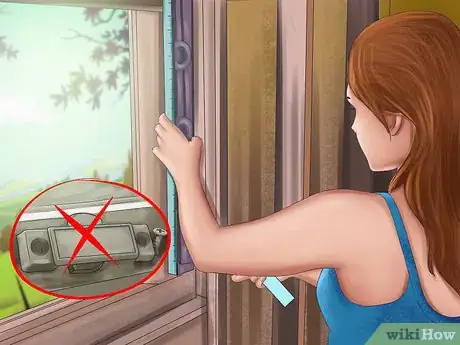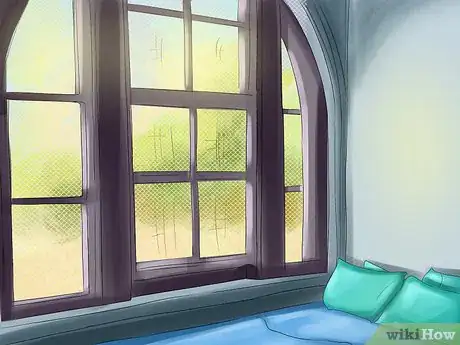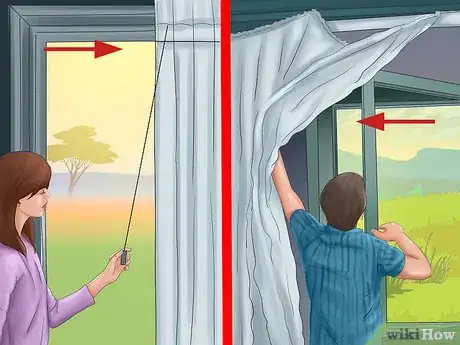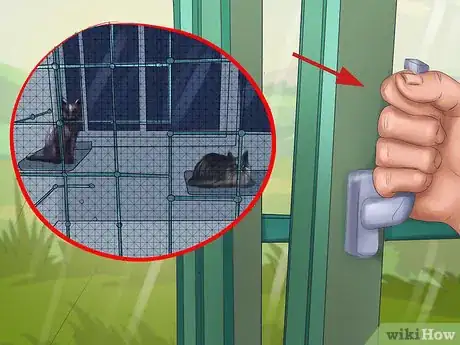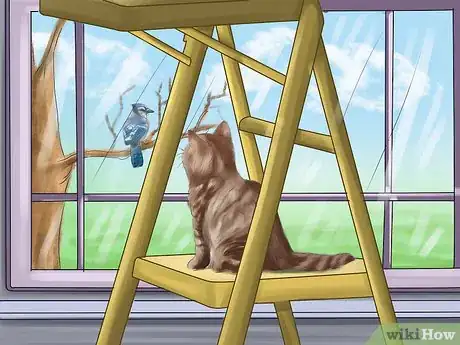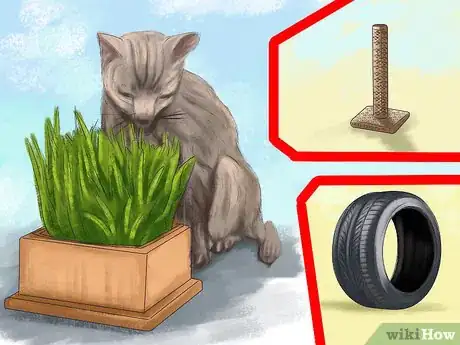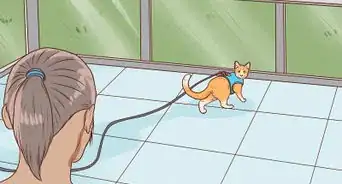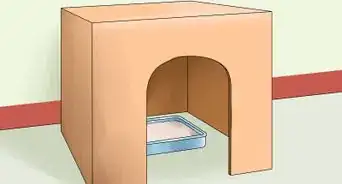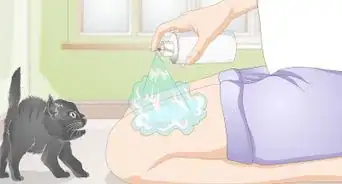This article was co-authored by Joey Lusvardi. Joey is a Cat Training & Behavior Expert and Owner of Class Act Cats based in Minneapolis, Minnesota. With five years of experience, Joey specializes in feline behavioral issues and customized treatment plans with the goal of integrating cats into their homes and families. Joey is a Certified Cat Behavior Consultant through the IAABC and a member of the Pet Professional Guild.
There are 11 references cited in this article, which can be found at the bottom of the page.
This article has been viewed 21,851 times.
Cats are inquisitive animals that love sitting in windows. This gives cats a chance to warm themselves in the sun and watch the action outside, including chirping birds that fly past. Cats have great balance, but a session in the window or trip on to a window ledge can be perilous for even the most spry pets. You can make your cat’s window sitting safe by securing the windows and creating a cozy “catio” for it in your window sill.
Steps
Securing Windows for Your Cat
-
1Check windows regularly. Consistent exposure to environmental elements such as rain, wind, and snow can damage the structure of a window and the glass pane. Inspecting the windows at least once a year can help you identify spots that could harm your cat.
- Shake the window gently. If it rattles, then it means the frame is not secure. This could make it easy for your cat to knock out the window or break it.[1]
- Look at the entire window frame and sill. If you can see outside from areas other than the pane, you have gaps. These may indicate wear that could potentially cause harm to your cat.
- Inspect the windowpane for cracks. These may break if your cat touches or jumps at the window. Your cat could fall out of the window or get cuts from the glass if this happens.
- Check windows that are double-hung. These should slide smoothly up and down. Windows that do not move smoothly or at all can fall on your cat and hurt it.
- Make sure latches that secure the window into one place are secure. Faulty latches may make the window fall down, which could harm your cat.
- Inspect any screens for tears, rips, or wear.
-
2Repair any damage. If you discover any damage to a window or windows your cat enjoys, take the time to repair the damage. Not only can this keep your cat safe, but also maintains the integrity of your home.[2]
- Replace windows, framing, latches, or screens that are severely damaged.
- Line a rattling window with some caulk and hammer a few nails into the surrounding frame.
- Seal any gap in window frames with some caulking and weather stripping around the frame.
- Have a professional repair small window cracks. If the crack is large or there are multiple cracks, consider replacing the windowpane.
- Patch holes in screens with a patch kit or according to their material. Use instant adhesive on nylon or fiberglass screens. Epoxy can fill holes in metal screens.[3]
Advertisement -
3Install window screens. If you don’t already have them, install window screens either throughout your home or in windows your cat likes to perch. Window screens allow your cat to enjoy a bit more of the outdoors than it would with closed windows. They also minimize the risk that your cat will fall out of the window.
- Avoid sliding screens, which your cat may be able to manipulate.[4]
- Get mosquito screens or pet-specific screens. You can get both types in a variety of materials such as vinyl, metal, nylon, or fiberglass.[5]
- Add safety locks or screw the screen in place to prevent your cat from accidentally opening the window.[6]
- Make sure the screens are securely installed before you allow your cat to enjoy them.
-
4Open windows at the top. Some homes have windows that open at the top and bottom. Check to see if your windows open from the top. If they do, consider letting your kitty get a smell of the outdoors and stay safe by only opening this portion of the window.[7]
- Check if your windows are “hotel-style” instead of top and bottom. You can open these windows to the side instead of out, which may also minimize the risk of injury for your cat.
-
5Remove pull cords. Blinds or curtains on your windows can present a choking or strangling hazard for cats. Getting rid of any dangling fabric or pull cords may minimize the risk of your cat injuring itself when enjoying its window seat.[8]
- Consider removing blinds completely if your cat tends to lunge at the window. This can keep your cat from getting stuck or injuring itself.
-
6Close windows when you are gone. Any time that you are not at home, close your windows. This is one of the best ways to ensure that your cat stays safe in a window. You may also want to consider closing windows when there are loud noises from inside or outside of your home. These can startle cats and may make them damage the window in an unsafe way.[9]
- Have or create a safe spot for your cat to enjoy the window while you are gone. This could be a cat tree or “catio” you make.
Constructing Safe Window Perches
-
1Construct a “catio” window bed. Cats are able to sit in windows for hours on end. If your cat loves its window time, construct a perch or window bed—a “catio”—for your cat to enjoy. This can provide a safe, non-slippery surface to enjoy the outdoors.[10]
- Use an old tray or other surface that fits your cat. Sand and scuff it up a bit. Glue on a piece of colorful fabric, wallpaper, or wrapping paper to the bottom of the tray.[11]
- Sew a pillowcase or use an old pillowcase and place a pillow in it as a seat for your cat.
- Add catnip-filled toys to the “catio” bed. Drill a hole in the tray and attach the toys with an eye screw.
- Drill holes for brackets in the seam of the window and in the tray. Then secure the brackets with screws and let your kitty enjoy its new “catio” space.
- Make any window sill into a “catio” if you don’t want to drill holes in your wall. Simply cover the sill with a piece of fabric and some batting for padding. This can provide as much enjoyment as a “catio” bed.
-
2Construct or purchase a cat tree. Cats love to watch and hunt small animals such as birds. They can watch and “hunt” from a window but you may be concerned about your cat being in the window. Make or buy a “cat tree” so that your cat can watch birds, squirrels and other small creatures. This may be an especially great way to amuse indoor cats, or outdoor cats that may be inside.
- Make your “cat tree” using things you have around the house. You may also want to consider building an actual “cat tree” with different level perches. Most pet stores also sell pre-fabricated “cat trees.”
- Place the “cat tree” near a window where your cat likes to sit. Having the different perches will give her different types of enjoyment that a window seat can’t provide.
- Open blinds or curtains so that your cat can watch what’s happening outside. Your cat may have so much fun that it makes noises or lunges at the window to “capture” prey.[12]
- Add features such as branches or hanging toys to make the cat tree interesting.[13]
-
3Bring the outdoors in. If your windows aren’t safe for your cat, try bringing some of the outdoors inside for it. Provide your cat any of the following to give it the enjoyment of the outdoors without sitting in the window or going outside:[14]
- Cat grass, which you can purchase or grow yourself
- Pesticide-free alfalfa
- Bird seed
- Catnip
- Tires
- Toys hanging from branches, especially life-like birds
- Videos of birds or other animals[15]
- Scratching pad made of natural fibers such as sisal
References
- ↑ https://www.houselogic.com/remodel/windows-doors-and-floors/how-inspect-windows-doors-stop-air-and-water-leaks/
- ↑ https://www.houselogic.com/remodel/windows-doors-and-floors/how-inspect-windows-doors-stop-air-and-water-leaks/
- ↑ http://www.marthastewart.com/275546/how-to-repair-window-screens#227320
- ↑ http://pets.thenest.com/make-windows-safe-cats-11539.html
- ↑ http://thecreativecat.net/windows-screens-and-cats-2/
- ↑ http://pets.thenest.com/make-windows-safe-cats-11539.html
- ↑ http://www.catster.com/lifestyle/stop-cats-falling-out-of-windows
- ↑ http://pets.thenest.com/make-windows-safe-cats-11539.html
- ↑ http://www.catster.com/lifestyle/stop-cats-falling-out-of-windows
- ↑ http://pets.thenest.com/make-windows-safe-cats-11539.html
- ↑ http://diyshowoff.com/2011/11/06/diy-cat-window-perch-and-diy-project-parade/
- ↑ http://www.humanesociety.org/animals/cats/tips/cat_happy_indoors.html
- ↑ http://www.njaudubon.org/Portals/10/CatsIndoors/PDF/outin.PDF
- ↑ http://www.njaudubon.org/Portals/10/CatsIndoors/PDF/outin.PDF
- ↑ http://www.thedailycat.com/behavior/behaviorseasonal/bringing_outdoors_inside/index.html
About This Article
You can make your cat’s favorite sitting window safer by removing any dangling pull cords on blinds or curtains that could be a strangling or choking hazard. If your cat likes to lunge at the window, consider taking down blinds completely so it doesn’t end up getting stuck or injuring itself. You should also inspect the window frame for any cracks or looseness because while it might seem insignificant, these issues could lead to breakage and injury if your cat jumps at the window. Check the latches on your windows as well to make sure they won’t accidentally cause the window to slam down unexpectedly and hurt your kitty. For more advice from our Veterinary co-author, like how to make a window bed for your cat to perch on, scroll down!
